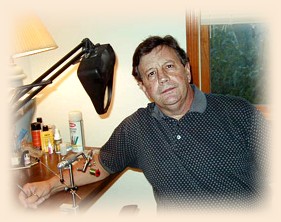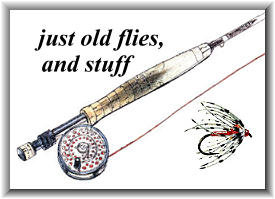This fly comes from James Hardy, whose book Salmon Fishing
was a late entry in the pantheon of classic salmon fly books,
appearing in 1907. The only other work that includes the pattern
is John Henry Hale's later edition, which includes all the Hardy
patterns. This may very well be a Hardy creation as earlier
authors don't refer to this fly.
As time went on in the classic period, the flies seemed to
get more and more complicated, and this one has some serious
complications. Many versions of this fly include the middle
joint or butt of ostrich herl, as mine does here, but
according to Mikael Frodin, that's a mistake. I disagree, as
the recipe clearly talks of a black ostrich herl butt, then
in the body section references silver tinsel, butted with
Indian crow. The fact that the word "butted" is used leads
me to believe a second butt was to be installed, but it
really comes down to semantics.
Mistake or not, it complicates matters greatly whether you
leave out the second joint or keep it in. If one leaves it
out, you have the touchy situation of trying to get a smooth
transition from the silver tinsel to the red floss, with two
Indian crow feathers and a hackle underneath. If one keeps
it in, there is the matter of the ribbing, which is wound
over everything. I tried on the first version I did to wind
it over everything, including the second joint, and that sure
doesn't work. It messes up that joint. On the second version
I wound the ribbing to the joint, then added the Indian crow
and butt, then continued the ribbing later after winding the
floss and tying in the hackle. No matter what you do, it's
dicey, and this fly is a tough one. Wayne Luallen, one of the
great tiers in the world, puts the joint in as I have, so I'll
use that as my "excuse" for doing it the way I did.
There is a strip wing fly also referred to in the Hardy book
called the Drummond, one that as far as I can see bears no
relation to this one. I've included both recipes below:
James Hardy's The Red Drummond
Tag: Silver tinsel and yellow floss silk.
Tail: A topping and Indian crow.
Butt: Black ostrich herl.
Body: First half silver tinsel, butted with
Indian crow. Second half red floss silk.
Rib: Silver tinsel over both halves.
Hackle: Red-claret hackle, over red floss silk.
Throat: Guinea fowl.
Wings: White tipped turkey, yellow, red and blue swan,
peacock wing, bustard, golden pheasant tail, wood duck, teal,
mallard over and a topping.
Sides: Jungle cock.
Cheeks: Chatterer.
Horns: Blue macaw.
Head: Black.
Drummond from Hardy Book
Tag: Silver tinsel.
Tail: A topping and ibis.
Body: Three turns of orange tinsel.
Hackle: A dark red cock's hackle, wound to the
shoulders, where a few extra turns comprise the throat.
Wing: Simple strip wing with two sections of dun turkey.
Head: Black.
Credits: Salmon Fishing by James Hardy;
Classic Salmon Flies by Mikael Frodin. ~ EA
About Eric:
 I started fly fishing as a teen in and around my hometown
of Plattsburgh, New York, primarily on the Saranac River.
I started tying flies almost immediately and spent hours
with library books written by Ray Bergman, Art Lee, and
A. J. McClane. Almost from the beginning I liked tying
just as much as I liked fishing and spent considerable
time at the vise creating hideous monstrosities that
somehow caught fish anyway. Then one day I came upon a
group of flies that had been put out at a local drug store
that had been tied by Francis Betters of Wilmington, N.Y.
My life changed that day and so did my flies, dramatically.
Even though I never met Fran back then, I've always
considered him to be one of my biggest influences.
I started fly fishing as a teen in and around my hometown
of Plattsburgh, New York, primarily on the Saranac River.
I started tying flies almost immediately and spent hours
with library books written by Ray Bergman, Art Lee, and
A. J. McClane. Almost from the beginning I liked tying
just as much as I liked fishing and spent considerable
time at the vise creating hideous monstrosities that
somehow caught fish anyway. Then one day I came upon a
group of flies that had been put out at a local drug store
that had been tied by Francis Betters of Wilmington, N.Y.
My life changed that day and so did my flies, dramatically.
Even though I never met Fran back then, I've always
considered him to be one of my biggest influences.
I had a career in music for twenty years or so and didn't
fish much, though I did fish at times. The band I was with
had its fifteen seconds of fame when we were asked to be in
John Mellencamp's movie "Falling From Grace." I am the
keyboard player on the right in the country club scene in
the middle of the movie. Don't blink. It's on HBO all the
time. We got to meet big Hollywood stars and record in John's
studio. It was a blast.
So how did I wind up contributing to the Just Old Flies
column on FAOL? I'm not sure, it was something that I simply
wanted very badly to do, and they let me. Many of the old flies
take me back to the Adirondacs and my youth, and I guess I get
to relive some of it through the column. I've spent many happy
hours fishing and tying over the years, and tying these flies
brings back memories of great days on the water, and intense
hours spent looking at the flies in the fly plates in the old
books and trying to get my flies to look like them. And now,
here I am, still doing that to this day. ~ EA
|


 I started fly fishing as a teen in and around my hometown
of Plattsburgh, New York, primarily on the Saranac River.
I started tying flies almost immediately and spent hours
with library books written by Ray Bergman, Art Lee, and
A. J. McClane. Almost from the beginning I liked tying
just as much as I liked fishing and spent considerable
time at the vise creating hideous monstrosities that
somehow caught fish anyway. Then one day I came upon a
group of flies that had been put out at a local drug store
that had been tied by Francis Betters of Wilmington, N.Y.
My life changed that day and so did my flies, dramatically.
Even though I never met Fran back then, I've always
considered him to be one of my biggest influences.
I started fly fishing as a teen in and around my hometown
of Plattsburgh, New York, primarily on the Saranac River.
I started tying flies almost immediately and spent hours
with library books written by Ray Bergman, Art Lee, and
A. J. McClane. Almost from the beginning I liked tying
just as much as I liked fishing and spent considerable
time at the vise creating hideous monstrosities that
somehow caught fish anyway. Then one day I came upon a
group of flies that had been put out at a local drug store
that had been tied by Francis Betters of Wilmington, N.Y.
My life changed that day and so did my flies, dramatically.
Even though I never met Fran back then, I've always
considered him to be one of my biggest influences.